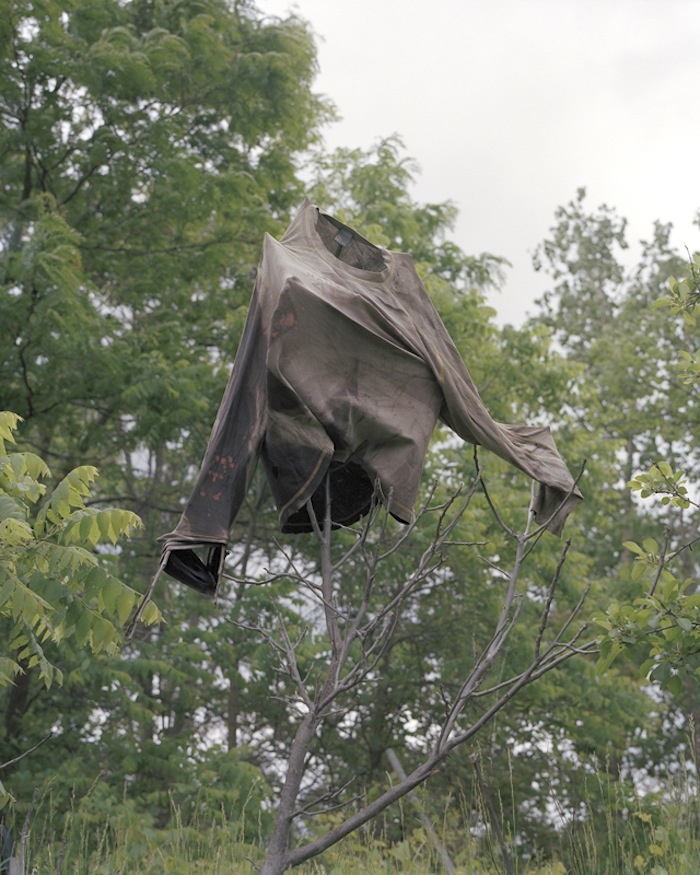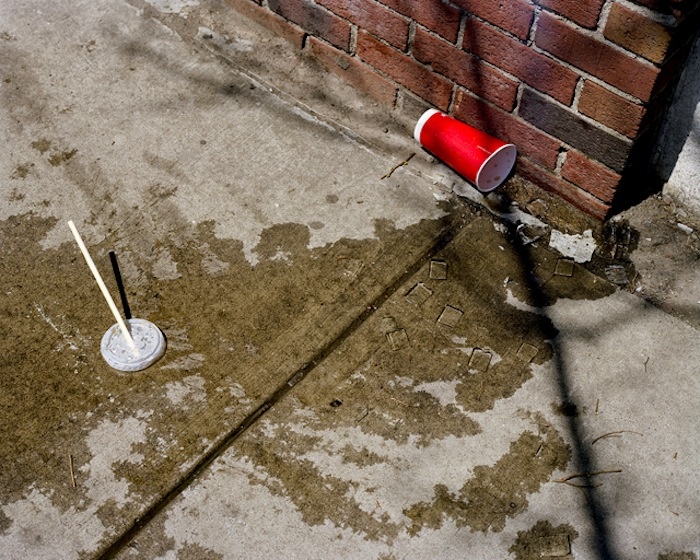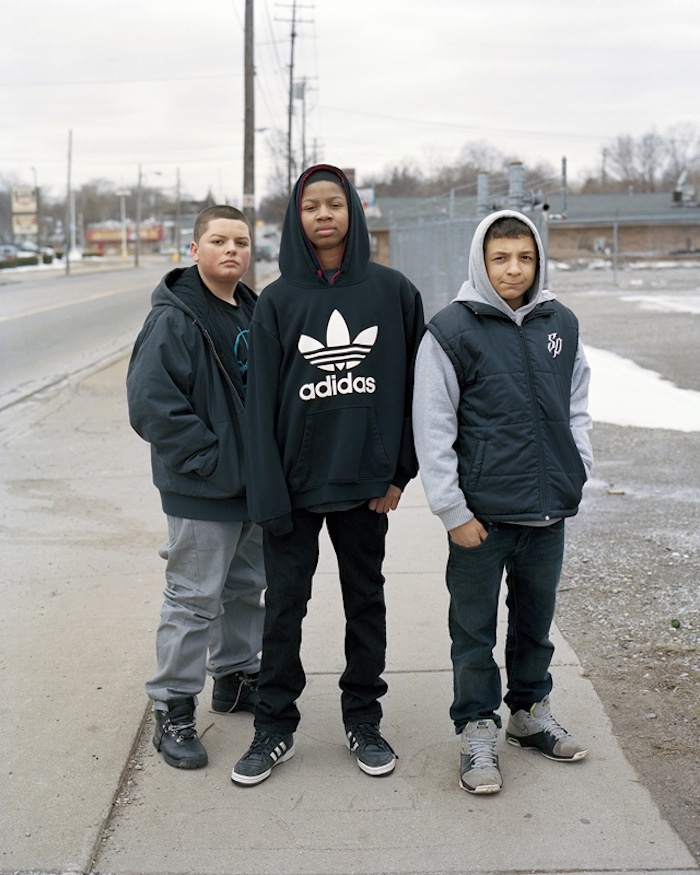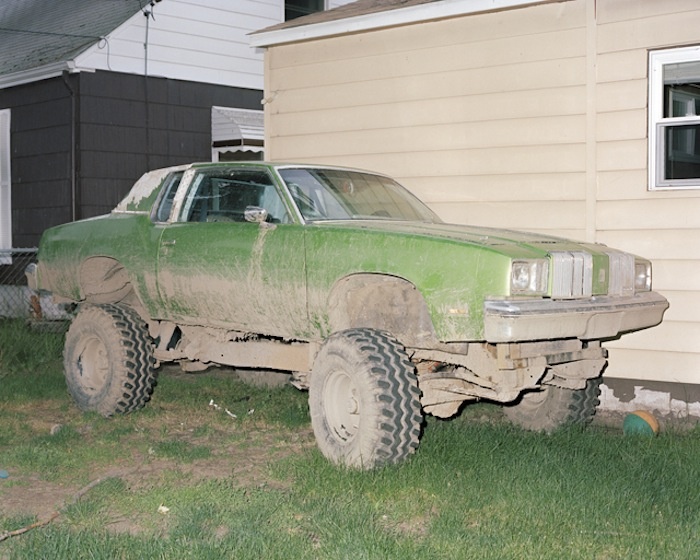Mossless in America is a column featuring interviews with documentary photographers. The series is produced in partnership with Mossless magazine, an experimental photography publication run by Romke Hoogwaerts and Grace Leigh. Romke started it in 2009 as a blog in which he interviewed a different photographer every two days; since 2012 the magazine has produced three print issues, each dealing with a different type of photography. Mossless was featured prominently in the landmark 2012 exhibition Millennium Magazine at the Museum of Modern Art in New York and it is supported by Printed Matter, Inc. Its third issue, a major photographic volume on American documentary photography from the last ten years, titled The United States (2003–2013), was published last May.
Advertisement
Hailing from the picturesque Catskill mountains, photographer Juan Madrid takes intimate portraits of the seemingly unapproachable as he chronicles and humanizes the once-great and now-fallen cities and towns of America. Focusing mainly on the quieter moments of these regions that haven't been covered by major media outlets, Madrid allows us to feel these places like we haven't before. We talked to Juan about rampant poverty, knife fights, and the problems with new growth in old cities.

VICE: Where are you from?
Juan Madrid: Catskill, New York. I studied photography at the Rochester Institute of Technology (RIT).You have an ongoing series that you've titled Welcome to Flint, which we featured in the latest issue of Mossless. We've heard that Flint, in Michigan, isn't the safest place. What brought you there?
Brett Carlsen, a friend and fellow photographer from RIT, was interning at The Flint Journal, a newspaper in the city. He invited me up to visit and work together on a project about the city and produce a collaborative publication. That was the summer before my last year at RIT, so I jumped at a chance to get out of New York (a place I'd spent my entire life), and try to push myself to look at photography in a different way before starting classes. I think that first week I spent in Flint changed how I understood photography in profound ways and pushed me to start photographing with more focus.
Juan Madrid: Catskill, New York. I studied photography at the Rochester Institute of Technology (RIT).You have an ongoing series that you've titled Welcome to Flint, which we featured in the latest issue of Mossless. We've heard that Flint, in Michigan, isn't the safest place. What brought you there?
Brett Carlsen, a friend and fellow photographer from RIT, was interning at The Flint Journal, a newspaper in the city. He invited me up to visit and work together on a project about the city and produce a collaborative publication. That was the summer before my last year at RIT, so I jumped at a chance to get out of New York (a place I'd spent my entire life), and try to push myself to look at photography in a different way before starting classes. I think that first week I spent in Flint changed how I understood photography in profound ways and pushed me to start photographing with more focus.
Advertisement
Do you have any stories to share from Flint?
One thing I won't forget is watching a drunken man one afternoon on the east side. He got completely naked and took a piss by some trees in an empty lot. And he was bathed in this golden light—it was really surreal. I wanted to take a photo, but it was over pretty quick and I was worried that he'd have a knife on him and didn't want to direct his attention to me. He had trouble getting his clothes back on and fell at least once. He headed down the street, and I followed him from a distance for a while, just to see if anything would happen. I eventually lost him. I walked back up the street and saw him sit up from some overgrown grass, he'd fallen again. He got back up and made his way back down the street, eventually starting a yelling match with a homeless man and threatening to kill the homeless man's dog. He kept going down the street and the homeless man disappeared only to come running down the street a minute or so later with a cane. He was furious about the threat against his dog and wanted to fight. The drunken man wanted him to put his weapon down, so he threw it aside. The drunken man did have a knife and pulled it out. He was a lot drunker than I thought, as the homeless man either punched or kicked him in the head right away and the knife went flying. The homeless man continued to kick him while he was on the ground, and then ran off before the police showed up. Some people had stopped to watch and were recording videos on their phones. I tried to find the knife after the homeless guy ran, but someone else had already grabbed it. Someone had called the cops, but the guy had gotten up, fairly dazed, his face bloody, and managed to start walking down the street again. He made it across the street before the cops came and took him in.
One thing I won't forget is watching a drunken man one afternoon on the east side. He got completely naked and took a piss by some trees in an empty lot. And he was bathed in this golden light—it was really surreal. I wanted to take a photo, but it was over pretty quick and I was worried that he'd have a knife on him and didn't want to direct his attention to me. He had trouble getting his clothes back on and fell at least once. He headed down the street, and I followed him from a distance for a while, just to see if anything would happen. I eventually lost him. I walked back up the street and saw him sit up from some overgrown grass, he'd fallen again. He got back up and made his way back down the street, eventually starting a yelling match with a homeless man and threatening to kill the homeless man's dog. He kept going down the street and the homeless man disappeared only to come running down the street a minute or so later with a cane. He was furious about the threat against his dog and wanted to fight. The drunken man wanted him to put his weapon down, so he threw it aside. The drunken man did have a knife and pulled it out. He was a lot drunker than I thought, as the homeless man either punched or kicked him in the head right away and the knife went flying. The homeless man continued to kick him while he was on the ground, and then ran off before the police showed up. Some people had stopped to watch and were recording videos on their phones. I tried to find the knife after the homeless guy ran, but someone else had already grabbed it. Someone had called the cops, but the guy had gotten up, fairly dazed, his face bloody, and managed to start walking down the street again. He made it across the street before the cops came and took him in.
Advertisement

How do you meet the subjects of your photographs?
I walk around a lot. I get a certain feeling when I see some people, and I need to take their portraits. Other times, I'll just try to stop people and chat, or people will start conversations with me. If I'm photographing in the same area for an extended period of time, rarely will I be introduced to people.There is this photograph from the series Sculptures of Ghosts (also featured in the last Mossless) that is one of our favorites in the book. The caption in the book reads, "This man had been tattooed by his father a year before his father's death. His father also tattooed the word priest on his neck. He used to live in Los Angles, but moved to Rochester in 2004." The image is completely arresting, what is the story behind this photograph?
Unfortunately, there isn't some amazing story behind this image. I was walking around Rochester when this guy walked by, and I stopped him and asked if I could take his portrait. We talked a little bit about where he was from and about the differences between Los Angeles and Rochester. Mostly small talk. He explained what the tattoo meant and I believe he said his father was Native American and the tattoo, if I'm remembering correctly, was spiritual in nature. I always meant to find him again, but never did.Flint used to be one of the country's largest car manufacturing city and now in its decline it's become one of the country's most dangerous cities. How are the people of Flint dealing with this decline?
People get by. That's the way it seems to be everywhere—you do what you need to do to survive, at least in the poorer neighborhoods. It's difficult because most of the people in Flint have no way out of Flint and realize this. It's the type of situation that forces crime to become the easiest way of survival. It seems as if the downtown area is becoming more robust, but I'm wary of that kind of growth. It addresses a symptom of American capitalism, rather than the disease, while compartmentalizing the poverty and violence. But people are helping the downtown area to grow and the presence of colleges definitely make that area safer and more prone to economic growth. There are also community organizations that try their hardest to fight the rampant poverty, whether it be youth groups, homeless shelters, or other types of aid.
I walk around a lot. I get a certain feeling when I see some people, and I need to take their portraits. Other times, I'll just try to stop people and chat, or people will start conversations with me. If I'm photographing in the same area for an extended period of time, rarely will I be introduced to people.There is this photograph from the series Sculptures of Ghosts (also featured in the last Mossless) that is one of our favorites in the book. The caption in the book reads, "This man had been tattooed by his father a year before his father's death. His father also tattooed the word priest on his neck. He used to live in Los Angles, but moved to Rochester in 2004." The image is completely arresting, what is the story behind this photograph?
Unfortunately, there isn't some amazing story behind this image. I was walking around Rochester when this guy walked by, and I stopped him and asked if I could take his portrait. We talked a little bit about where he was from and about the differences between Los Angeles and Rochester. Mostly small talk. He explained what the tattoo meant and I believe he said his father was Native American and the tattoo, if I'm remembering correctly, was spiritual in nature. I always meant to find him again, but never did.Flint used to be one of the country's largest car manufacturing city and now in its decline it's become one of the country's most dangerous cities. How are the people of Flint dealing with this decline?
People get by. That's the way it seems to be everywhere—you do what you need to do to survive, at least in the poorer neighborhoods. It's difficult because most of the people in Flint have no way out of Flint and realize this. It's the type of situation that forces crime to become the easiest way of survival. It seems as if the downtown area is becoming more robust, but I'm wary of that kind of growth. It addresses a symptom of American capitalism, rather than the disease, while compartmentalizing the poverty and violence. But people are helping the downtown area to grow and the presence of colleges definitely make that area safer and more prone to economic growth. There are also community organizations that try their hardest to fight the rampant poverty, whether it be youth groups, homeless shelters, or other types of aid.
Advertisement

What about Rochester, which you cover in Sculptures of Ghosts? What kind of decline did that city experience?
Rochester experienced a similar fall to Flint and other Rust Belt cities. A large business lost the ability to make large profits (though in this case it was more because Kodak couldn't develop new technology), and had to cut its workforce down by a massive amount, leaving those it dropped to fend for themselves. Population dropped, crime rose—though statistics never tell the full story, which is something to keep in mind when cities are labeled "violent." I think of these types of cities as sacrificial cities. They had to fall for American capitalism to continue on in the never-ending exploitations of anything deemed to have value, as well as the incessant search for maximum profitability, a system in which people aren't valuable for anything other than their production. And once that production loses its value, those people and the cities they inhabit fall.
Rochester experienced a similar fall to Flint and other Rust Belt cities. A large business lost the ability to make large profits (though in this case it was more because Kodak couldn't develop new technology), and had to cut its workforce down by a massive amount, leaving those it dropped to fend for themselves. Population dropped, crime rose—though statistics never tell the full story, which is something to keep in mind when cities are labeled "violent." I think of these types of cities as sacrificial cities. They had to fall for American capitalism to continue on in the never-ending exploitations of anything deemed to have value, as well as the incessant search for maximum profitability, a system in which people aren't valuable for anything other than their production. And once that production loses its value, those people and the cities they inhabit fall.

Buy Juan Madrid's photo book Waiting on the Dream through VUU Collective, and visit his website to see more of his work.Follow Mossless on Twitter.